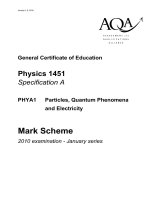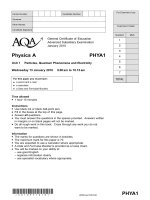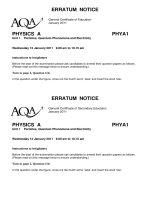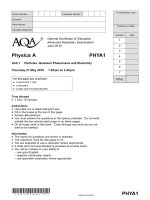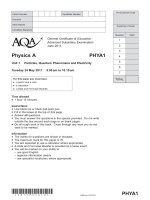- Trang chủ >>
- Khoa Học Tự Nhiên >>
- Vật lý
Vật lý A level:AQA PHYA2 QP JAN12
Bạn đang xem bản rút gọn của tài liệu. Xem và tải ngay bản đầy đủ của tài liệu tại đây (829.77 KB, 16 trang )
WMP/Jan12/PHYA2
PHYA2
Centre Number
Surname
Other Names
Candidate Signature
Candidate Number
General Certificate of Education
Advanced Subsidiary Examination
January 2012
Time allowed
l
1 hour 15 minutes
Instructions
l
Use black ink or black ball-point pen.
l
Fill in the boxes at the top of this page.
l
Answer all questions.
l
You must answer the questions in the spaces provided. Do not write
outside the box around each page or on a blank page.
l
Do all rough work in this book. Cross through any work you do not
want to be marked.
l
Show all your working.
Information
l
The marks for questions are shown in brackets.
l
The maximum mark for this paper is 70.
l
You are expected to use a calculator where appropriate.
l
A Data and Formulae Booklet is provided as a loose insert.
l
You will be marked on your ability to:
– use good English
– organise information clearly
– use specialist vocabulary where appropriate.
For this paper you must have:
l
a pencil and a ruler
l
a calculator
l
a Data and Formulae Booklet (enclosed).
Physics A PHYA2
Unit 2 Mechanics, Materials and Waves
Friday 20 January 2012 9.00 am to 10.15 am
MarkQuestion
For Examiner’s Use
Examiner’s Initials
TOTAL
1
2
3
4
5
6
7
(JAN12PHYA201)
WMP/Jan12/PHYA2
Do not write
outside the
box
Answer all questions in the spaces provided.
1 Sail systems are being developed to reduce the running costs of cargo ships. The sail
and ship’s engines work together to power the ship. One of these sails is shown in
Figure 1 pulling at an angle of 40
o
to the horizontal.
Figure 1
1 (a) The average tension in the cable is 170 kN.
Show that, when the ship travels 1.0 km, the work done by the sail on the ship
is 1.3 × 10
8
J.
(2 marks)
1 (b) With the sail and the engines operating, the ship is travelling at a steady speed
of 7.0 m s
–1
.
1 (b) (i) Calculate the power developed by the sail.
answer = W
(2 marks)
(02)
2
tension
40º
WMP/Jan12/PHYA2
Do not write
outside the
box
1 (b) (ii) Calculate the percentage of the ship’s power requirement that is provided by the wind
when the ship is travelling at this speed.
The power output of the engines is 2.1 MW.
answer = %
(2 marks)
1 (c) The angle of the cable to the horizontal is one of the factors that affects the horizontal
force exerted by the sail on the ship. State two other factors that would affect this
force.
Factor 1
Factor 2
(2 marks)
Turn over for the next question
(03)
3
Tur n over
ᮣ
8
WMP/Jan12/PHYA2
Do not write
outside the
box
2 An ‘E-bike’ is a bicycle that is assisted by an electric motor. Figure 2 shows an E-bike
and rider with a total mass of 83 kg moving up an incline.
Figure 2
2 (a) (i) The cyclist begins at rest at A and accelerates uniformly to a speed of 6.7 m s
–1
at B.
The distance between A and B is 50 m.
Calculate the time taken for the cyclist to travel this distance.
answer = s
(2 marks)
2 (a) (ii) Calculate the kinetic energy of the E-bike and rider when at B. Give your answer to an
appropriate number of significant figures.
answer = J
(2 marks)
(04)
4
3.0 m
50
m
A
B
WMP/Jan12/PHYA2
Do not write
outside the
box
2 (a) (iii) Calculate the gravitational potential energy gained by the E-bike and rider between A
and B.
answer = J
(2 marks)
2 (b) Between A and B, the work done by the electric motor is 3700 J, and the work done by
the cyclist pedalling is 5300 J.
2 (b) (i) Calculate the wasted energy as the cyclist travels from A to B.
answer = J
(2 marks)
2 (b) (ii) State two causes of this wasted energy.
Cause 1
Cause 2
(2 marks)
Turn over for the next question
(05)
5
Tur n over
ᮣ
10
WMP/Jan12/PHYA2
Do not write
outside the
box
3 Figure 3 shows an aircraft designed to take off and land vertically and also to hover
without horizontal movement. In order to achieve this, upward lift is produced by
directing the jet engine outlet downwards. The engine also drives a vertical lift fan near
the front of the aircraft. The weight of the aircraft is 180 kN. The distance between the
lift fan and the centre of mass is 4.6 m and the distance between the jet engine outlet
and the centre of mass is 2.8 m.
Figure 3
3 (a) (i) Calculate the moment caused by the weight of the aircraft about the point X.
answer = N m
(2 marks)
3 (a) (ii) By taking moments about X, calculate the lift fan thrust if the aircraft is to remain
horizontal when hovering.
answer = N
(3 marks)
(06)
6
lift fan
outlet
centre
of mass
jet engine
outlet
X
180
kN
weight
4.6 m
lift fan
thrust
engine
thrust
2.8 mlift fan
WMP/Jan12/PHYA2
Do not write
outside the
box
(07)
7
Tur n over
ᮣ
3 (a) (iii) Calculate the engine thrust in Figure 3.
answer = N
(1 mark)
3 (b) Having taken off vertically, the jet engine outlet is turned so that the engine thrust acts
horizontally. The aircraft accelerates horizontally to a maximum velocity. The forward
thrust produced by the jet is 155 kN. The weight of the aircraft is 180 kN.
3 (b) (i) When the resultant horizontal force is 155 kN, calculate the horizontal acceleration of
the aircraft.
answer = m s
–2
(2 marks)
3 (b) (ii) State and explain one characteristic of the aircraft that limits its maximum horizontal
velocity.
(2 marks)
Question 3 continues on the next page
WMP/Jan12/PHYA2
Do not write
outside the
box
3 (b) (iii) On the axes below, sketch the velocity-time graph for the horizontal motion of the
aircraft as it accelerates from zero to its maximum horizontal velocity.
(2 marks)
3 (c) State how a velocity-time graph could be used to find the maximum acceleration.
(1 mark)
Turn to page 10 for the next question
8
(08)
0
0 time
horizontal
velocity
13
WMP/Jan12/PHYA2
Do not write
outside the
box
(09)
9
Tur n over
ᮣ
There are no questions printed on this page
DO NOT WRITE ON THIS PAGE
ANSWER IN THE SPACES PROVIDED
WMP/Jan12/PHYA2
(10)
Do not write
outside the
box
10
4 Figure 4 shows a stress-strain graph for a copper wire.
Figure 4
4 (a) Define tensile strain.
(1 mark)
4 (b) State the breaking stress of this copper wire.
answer = Pa
(1 mark)
4 (c) Mark on Figure 4 a point on the line where you consider plastic deformation may start.
Label this point A.
(1 mark)
4 (d) Use the graph to calculate the Young modulus of copper. State an appropriate unit for
your answer.
answer =
(3 marks)
0.0
0.0 1.0 2.0 3.0
strain
/ 10
–3
fracture
4.0
5.0 5.5 6.00.5 1.5 2.5 3.5 4.5
0.4
0.8
1.2
1.6
1.8
2.0
stress
/ 10
8
Pa
0.2
0.6
1.0
1.4
WMP/Jan12/PHYA2
Do not write
outside the
box
4 (e) The area under the line in a stress-strain graph represents the work done per unit volume
to stretch the wire.
4 (e) (i) Use the graph to find the work done per unit volume in stretching the wire to a strain
of 3.0 × 10
–3
.
answer = J m
–3
(2 marks)
4 (e) (ii) Calculate the work done to stretch a 0.015 kg sample of this wire to a strain of
3.0 × 10
–3
.
The density of copper = 8960 kg m
–3
.
answer = J
(2 marks)
4 (f) A certain material has a Young modulus greater than copper and undergoes brittle
fracture at a stress of 176 MPa.
On Figure 4 draw a line showing the possible variation of stress with strain for this
material.
(2 marks)
Turn over for the next question
11
(11)
Turn over
ᮣ
12
WMP/Jan12/PHYA2
Do not write
outside the
box
5 (a) In an experiment, a narrow beam of white light from a filament lamp is directed at
normal incidence at a diffraction grating. Complete the diagram in Figure 5 to show
the light beams transmitted by the grating, showing the zero-order beam and the
first-order beams.
Figure 5
(3 marks)
5 (b) Light from a star is passed through the grating.
Explain how the appearance of the first-order beam can be used to deduce one piece of
information about the gases that make up the outer layers of the star.
(2 marks)
5 (c) In an experiment, a laser is used with a diffraction grating of known number of lines per
mm to measure the wavelength of the laser light.
5 (c) (i) Draw a labelled diagram of a suitable arrangement to carry out this experiment.
(2 marks)
12
(12)
narrow
beam
filament
lamp
grating
WMP/Jan12/PHYA2
Do not write
outside the
box
5 (c) (ii) Describe the necessary procedure in order to obtain an accurate and reliable value for
the wavelength of the laser light.
Your answer should include details of all the measurements and necessary calculations.
The quality of your written communication will be assessed in your answer.
(6 marks)
(13)
13
Tur n over
ᮣ
13
WMP/Jan12/PHYA2
Do not write
outside the
box
6 Figure 6 shows a glass prism. Light is directed into the prism at an angle of 56
o
.
The path of the ray of light is shown as is it enters the prism.
Figure 6
6 (a) (i) Calculate the refractive index of the glass.
answer =
(2 marks)
6 (a) (ii) Calculate the critical angle for the glass-air boundary.
answer = degrees
(2 marks)
6 (b) On Figure 6, continue the path of the ray of light until it emerges from the prism.
(2 marks)
14
(14)
6
56°
30°
60°
30°
ray of
light
WMP/Jan12/PHYA2
Do not write
outside the
box
7 Figure 7 shows a continuous progressive wave on a rope. There is a knot in the rope.
Figure 7
7 (a) Define the amplitude of a wave.
(2 marks)
7 (b) The wave travels to the right.
Describe how the vertical displacement of the knot varies over the next complete cycle.
(3 marks)
7 (c) A continuous wave of the same amplitude and frequency moves along the rope from the
right and passes through the first wave. The knot becomes motionless.
Explain how this could happen.
(3 marks)
END OF QUESTIONS
15
(15)
8
direction of wave motion
rope
knot
equilibrium position
WMP/Jan12/PHYA2
(16)
16
Copyright © 2012 AQA and its licensors. All rights reserved.
There are no questions printed on this page
DO NOT WRITE ON THIS PAGE
ANSWER IN THE SPACES PROVIDED

